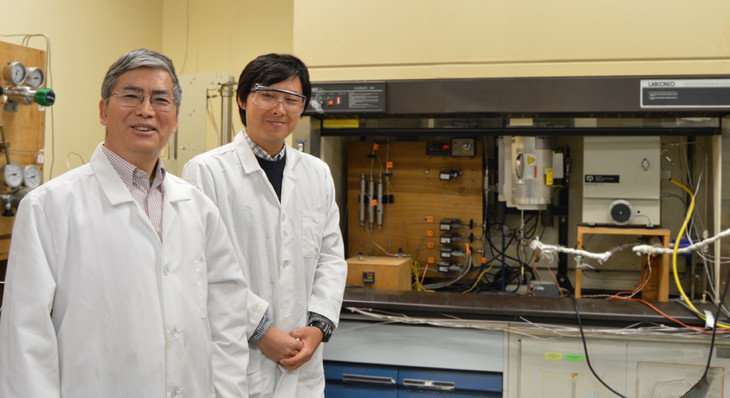Carbon dioxide-to-methanol process improved by catalyst

Dramatic improvements have been made to the process of converting carbon dioxide, a greenhouse gas, to methanol, a fuel and building block for a wide range of everyday materials, according to Penn State researchers.
Atmospheric carbon dioxide concentrations are increasing and climate change is becoming a worldwide concern requiring global efforts to reduce carbon dioxide emissions. One approach is to use carbon dioxide as the carbon source in reactions with hydrogen, where the hydrogen is produced from water using renewable energy, and the reaction synthesizes methanol. This will help reduce carbon dioxide emissions and mitigate dependence on fossil fuels.
Researchers have advanced the process of converting carbon dioxide into methanol, which contains four parts hydrogen, one part oxygen and one part carbon, by developing a new catalyst that uses a specific formulation of palladium and copper. The theoretical and experimental work, recently published in ACS Catalysis, is the result of years of integrated experimental and computational research conducted in a partnership with Dalian University of Technology in China in conjunction with the Penn State-Dalian Joint Center for Energy Research. The Penn State-Dalian collaborative research unearthed the benefits of combining the two metals as the catalyst.
A key factor in converting carbon dioxide to methanol is finding a good catalyst so that methanol can be produced in high selectivity at an efficient rate. In the palladium-to-copper atomic ratio range of 0.3 to 0.4, combining palladium and copper yielded the most efficient conversion of methanol from carbon dioxide using nanoparticles of the catalyst dispersed on a porous support material that increased the surface area of the catalyst. With a catalyst the size of a walnut, the internal surface area of the catalyst would cover about the area of a football field.
Researchers found that the new formulations, using the precise atomic ratio of the two metals, increased the rate of methanol formation by three times over palladium alone and by four times over copper alone, representing a significant improvement over previous methods.
Chunshan Song, distinguished professor of fuel science, professor of chemical engineering and director of the Earth and Mineral Sciences' (EMS) Energy
Institute, likened the process to a cat catching a mouse on the surface of a catalyst. For the conversion to occur, you need both carbon dioxide—the cat—and hydrogen—the mouse. But you need to create the ideal conditions for the cat to successfully catch the mouse. If the cat can't reach the mouse, or conditions slow it down, the cat has less success.
This works because the catalyst combining two metals can not only lower the energetic requirements to speed up the reaction of carbon dioxide and hydrogen, but also alters the reaction pathways to produce more desired product with higher energy efficiency.
"Conventional studies focused on copper but that doesn't yield efficient results," Song said. "It's the same for palladium. But putting palladium and copper together creates a unique surface structure that shows a special selectivity to creating methanol from carbon dioxide. This study provides the fundamental insights into the very synergetic effects of using these two metals together."
To create methanol, researchers pumped hydrogen and carbon dioxide into a sealed chamber of a reactor vessel packed with the catalyst and heated the contents to between 356 and 482 degrees Fahrenheit. The maximum carbon dioxide-to-methanol conversion is about 24 percent, however the unconverted carbon dioxide and hydrogen will be recycled and returned to the vessel in an industrial setting, much like what is done in conventional methanol synthesis using carbon monoxide and hydrogen.
The carbon dioxide hydrogenation process works by decomposing water to create a hydrogen gas using renewable energy, which then bonds with the carbon dioxide on the surface of the catalyst to create methanol. Song said that because their catalyst encourages high selectivity a larger percentage of the products go to creating methanol.
Methanol is used to create many materials and fuels, from adhesives and plywood subfloors to water bottles, wrinkle-resistant shirts and diesel fuels. It is also a chemical used in making antifreeze, windshield washer fluid, solvents and other products. New catalysts for converting carbon dioxide to a number of industrially useful chemicals, fuels, and materials such as plastics are being actively developed by Song through the Penn State-Dalian Joint Center for Energy Research.
Song said efficiently creating fuels and industrial chemicals from carbon dioxide using renewable energy is considered the holy grail for combating climate change because the fuels are even better than carbon-neutral or renewable fuels. The process essentially converts greenhouse gases to fuels that emit carbon dioxide when burned. This process, when combined with the capture of carbon dioxide from the environment, amounts to recycling carbon dioxide instead of creating or avoiding it.
"Our current energy system largely relies on carbon-based fossil energies," Song said. "Even renewable fuels such as biomass, biogas and organic waste, they are all carbon based. But in the future, where does carbon come from? If we begin using carbon from carbon dioxide, we can recycle it, create a sustainable carbon-based energy cycle, and then we stabilize the carbon dioxide concentration in the atmosphere. That's why I'm passionate about this."
Journal information: ACS Catalysis
Provided by Pennsylvania State University





















